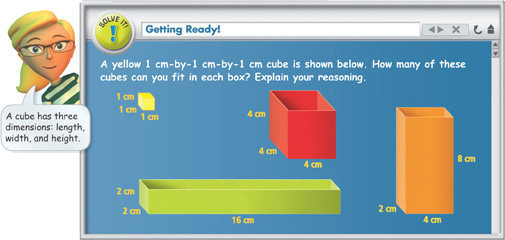11-4 Volumes of Prisms and Cylinders
Objective
To find the volume of a prism and the volume of a cylinder
 Dynamic Activity
Dynamic Activity
Volumes of Prisms and Cylinders
 Lesson Vocabulary
Lesson Vocabulary
- volume
- composite space figure
In the Solve It, you determined the volume of a box by finding how many 1 cm-by-1 cm-by-1 cm cubes the box holds.
Volume is the space that a figure occupies. It is measured in cubic units such as

Essential Understanding You can find the volume of a prism or a cylinder when you know its height and the area of its base.
Both stacks of paper below contain the same number of sheets.

The first stack forms an oblique prism. The second forms a right prism. The stacks have the same height. The area of every cross section parallel to a base is the area of one sheet of paper. The stacks have the same volume. These stacks illustrate the following principle.
Table of Contents
- 6-1 The Polygon Angle-Sum Theorems
- 6-2 Properties of Parallelograms
- 6-3 Proving That a Quadrilateral Is a Parallelogram
- 6-4 Properties of Rhombuses, Rectangles, and Squares
- 6-5 Conditions for Rhombuses, Rectangles, and Squares
- 6-6 Trapezoids and Kites
- 6-7 Polygons in the Coordinate Plane
- 6-8 and 6-9 Coordinate Geometry and Coordinate Proofs





